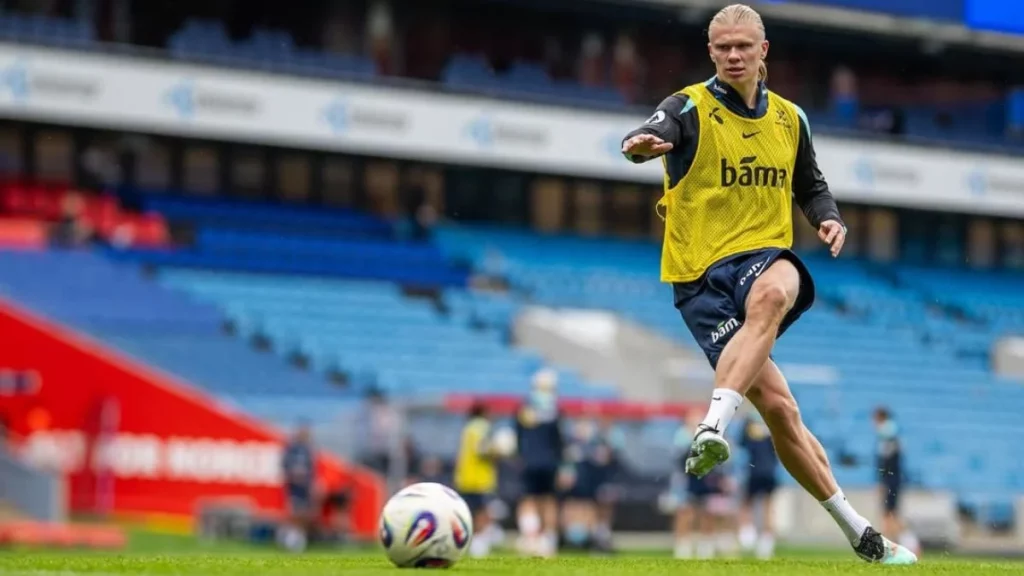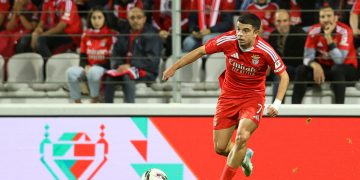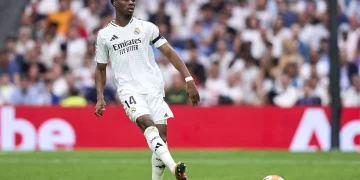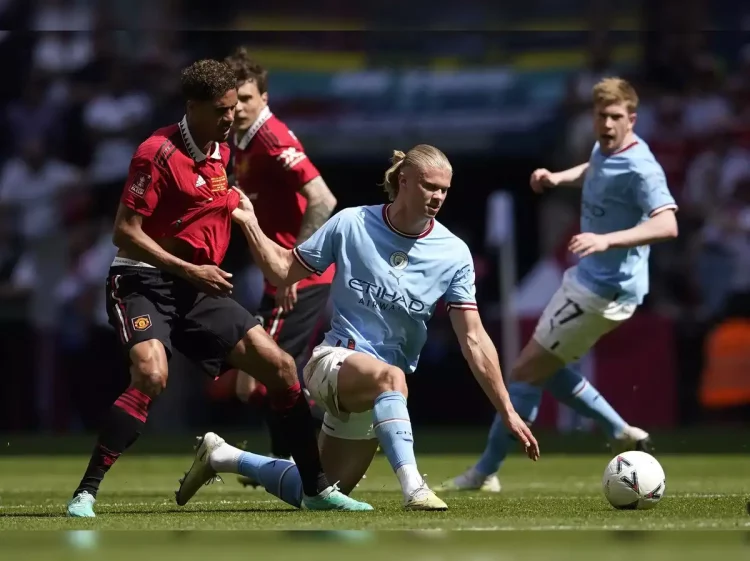When Erling Haaland arrived at Manchester City, there were two major schools of thought. One saw him as the missing piece in Pep Guardiola’s quest for a traditional No. 9—someone to finish off intricate team moves with clinical brutality. The other worried whether such a physically dominant but technically limited forward could thrive in a side built on intricate positional play. Two seasons later, Haaland has shattered scoring records, clinched trophies, and left behind a new prototype for what a modern target forward can be—even without ever dramatically evolving his technical toolkit.
It’s a paradox. Haaland is not particularly gifted in tight control, doesn’t link up like Benzema, or glide past defenders like Kane. And yet, he scores goals in volumes that no other elite forward matches consistently. He’s redefining the concept of a striker not by expanding his technical ceiling but by optimizing everything else—his movement, timing, physicality, and decision-making. The very idea of what a “complete” striker is has shifted—and Haaland is the reason.
Let’s explore how this transformation came to be, through aerial analytics, limited-touch analysis, and growing debates about his dependence on system context.
Aerial Dominance Analytics Breakthroughs
Standing at 6’5″ with a vertical leap more suited to the NBA than the Premier League, Haaland’s aerial presence is a force of nature. But what has changed in 2025 isn’t just his physical dominance—it’s how it’s being measured, refined, and deployed. Advanced aerial analytics now track not only headers won, but expected aerial value (xAV)—a metric that accounts for body positioning, header direction, defensive proximity, and pressure context.
Haaland consistently ranks in the 98th percentile for contested aerial wins in high-danger zones—those within the penalty arc. While many tall strikers win headers near midfield or in defensive clearances, Haaland’s aerial metrics are skewed almost entirely toward offensive actions. Whether it’s attacking the near post, hanging off a full-back, or backpedaling into open space at the far post, he manipulates defenders before the ball arrives, rather than reacting late.
Manchester City’s data scientists and analysts have crafted bespoke crossing patterns to exploit this strength. Haaland’s most productive zone? The area between the penalty spot and the six-yard box, slightly to the left—a region now nicknamed “the launchpad” by training staff. City’s inverted wingers and overlapping fullbacks aim their deliveries toward this pocket, often targeting Haaland’s third run—not the initial movement but a delayed adjustment after the first pull of a marker.
Another layer of analytics involves jump-timing. Unlike traditional aerial strikers who rely on brute strength, Haaland times his jumps with split-second precision to meet balls at their apex. High-speed motion tracking shows that his vertical leap initiates just as the cross hits its highest parabola. It’s less about hang-time and more about synchronization—a concept borrowed from volleyball and applied ruthlessly in football.
This has forced defenders to adjust. Fullbacks now double up earlier. Central defenders pre-rotate toward him. But none of it seems to matter. Haaland isn’t winning the aerial duel anymore—he’s rendering the duel irrelevant by getting there first, with better positioning and anticipation. The old rule of aerial play—who jumps higher or pushes harder—has been rewritten by a striker who wins with geometry and timing.
Limited-Touch Efficiency Studies
Perhaps the most jarring statistic in modern football is this: in many games, Haaland touches the ball fewer than 20 times, yet scores twice. In some matches, he completes fewer passes than his own goalkeeper. And still, he leaves the pitch as the game’s most decisive figure. For decades, low touch count in elite strikers was seen as a weakness—evidence of isolation, poor involvement, or lack of technique. Haaland has flipped this assumption on its head.
The concept of limited-touch efficiency—or LTE—is increasingly central to how forwards are judged in modern systems. LTE doesn’t merely analyze goals per touch. It looks at shot quality per touch, successful progressive involvement, and total impact per minute in possession. Haaland’s numbers are off the charts.
Let’s take his Premier League season in 2024/25. He averaged just 1.4 touches inside the box per goal—by far the lowest in Europe’s top five leagues. His shot-to-touch ratio was an absurd 1 in every 2.8 touches. For comparison, Mbappé stood at 1 in 5.4 and Harry Kane at 1 in 4.9. That means Haaland needs fewer actions to generate danger than anyone else. He doesn’t chase the ball. The ball comes to him, and when it does, he has already decided what comes next.
This is where his intelligence shines. Haaland doesn’t try to dribble past three defenders or thread clever one-twos in crowded zones. He plays the percentages. He sprints into space when the fullback drifts. He positions himself between blind zones in zonal marking schemes. He arrives, finishes, walks away. It’s the footballing equivalent of a sniper, not a gunslinger.
Critics often point to his low involvement in build-up play as a limitation. But Guardiola doesn’t need him to be David Silva or even Gabriel Jesus. Haaland’s genius lies in his minimalism. In a team designed to control every blade of grass, his job is to distort shape, pin defenders, and finish. Efficiency is the new artistry.

System Dependency Debates
Of course, no conversation about Haaland’s evolution is complete without addressing the elephant in the room: how much of this is him, and how much is the system?
Manchester City under Pep Guardiola is a well-oiled machine that churns out high-quality chances like a factory. With elite ball progressors like Kevin De Bruyne, Phil Foden, and Rodri feeding him, it’s tempting to believe that Haaland is merely a byproduct of the system—a supercharged poacher in a lab-controlled environment. Critics argue that if you placed him in a team without 60% possession, his lack of link-up play or ability to create his own chances would be brutally exposed.
And to an extent, they’re right. Haaland thrives in structured dominance. When Norway play against compact defenses, he struggles to drop deep, dribble, or combine creatively. His performances at Euro 2024 were solid but not electrifying. He was marked out of games because Norway couldn’t supply him at the same volume or quality.
But this critique misses the broader point. Most elite strikers are system-dependent. Lewandowski at Bayern, Kane at Spurs, even Benzema at Madrid—they all flourished in environments tailored to their strengths. What makes Haaland exceptional is that his strengths are so extreme, they can shape a system around them, rather than merely plug into one.
Guardiola had to adapt his philosophy to accommodate Haaland—less positional rotation in the final third, more verticality, and quicker release of the final ball. City are more direct now, less obsessed with sterile domination. They press higher and win the ball back sooner—not to recycle possession but to feed Haaland immediately. In this sense, Haaland is both a product and an architect of the system. The dependency is mutual.
Moreover, the system debate ignores his psychological edge. Haaland’s mentality is monstrous. He trains like an Olympian, studies like an analyst, and plays like a predator. His hunger to score, game after game, minute after minute, is what turns opportunities into outcomes. You can’t coach that. Systems create chances. Players finish them. Haaland does the latter better than anyone on Earth.
A Redefinition in Progress
What Haaland has done is not invent a new kind of striker—but reinvent what effectiveness looks like. He’s shown that you don’t need to be a technical maestro to be the world’s best. You don’t need to take 70 touches per game or complete 90% of your passes. You need to specialize in chaos, exploit margins, and punish every error.
His style isn’t about the ball—it’s about the moment. He is less the conductor of play, more the executioner. And as football becomes faster, more analytical, and more space-conscious, his approach feels more future-proof than ever.
That’s not to say he has no flaws. His first touch can still be clumsy. He doesn’t drop between the lines to create numerical advantages. He can look invisible in games where service is lacking. But even on his worst days, defenders still mark him with fear. Systems still shift to contain him. And space opens for others because of his mere presence.
So has Haaland grown technically? Not by much. But he didn’t need to. He’s grown tactically, spatially, psychologically—and in today’s game, that’s the evolution that matters.
In 2025, the idea of a “complete striker” is no longer about doing everything. It’s about doing the few things that matter most, better than anyone else. In that domain, Erling Haaland stands alone.


































Discussion about this post